Pink flowers always spread a distinct aura in the environment – an aura of femininity, beauty, and charm. With the abundance of positivity they exude, pink blossoms are everyone’s favorite to include on any occasion.
Being a flora faerie, you won’t be able to ignore the charm of these pink flowers. Through this article, delve into the beauty of 85 vibrant pink flowers and learn how you can grow them in your garden.
55 People’s Favorite Pink Flower Names
Every nation is brimming with distinct types of pink flowers, ranging from adorable baby pinks to vivid magenta marvels. To introduce you to the sheer number of pink beauties, here’s a quick tease of 55 flowers that are always blushing in shades of pink.
Quick Fact: Hardiness zones are geographical regions, grouped by climate, that are used to predict the ideal growing conditions for various plants. Based on the average yearly minimum winter temperature, the USDA Plant Hardiness Zone Map divides the United States and Canada into 13 zones.
Pink Orchids
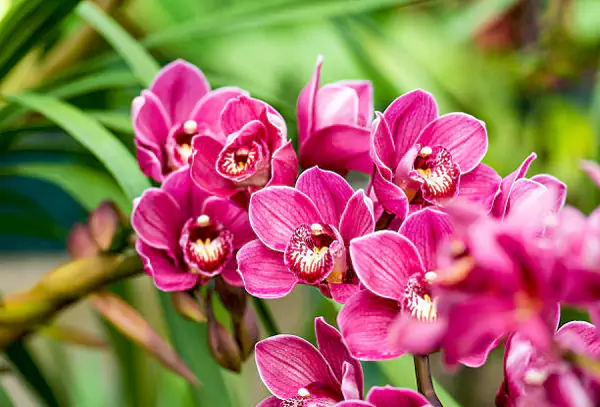
| Botanical Name: | Orchidaceae |
| Sunlight Required: | Full Sun |
| Hardiness Zones (USDA): | 2 – 11 |
| Blooming Period: | Spring to fall |
| Preferred Soil: | Well-drained, loamy soil |
Given that there are 30,000 species of orchids in the world, it is not a surprise to find these blooms at the top of the list. These attractive blossoms, known for their symmetry, come in every possible shade of pink!
Zinnia
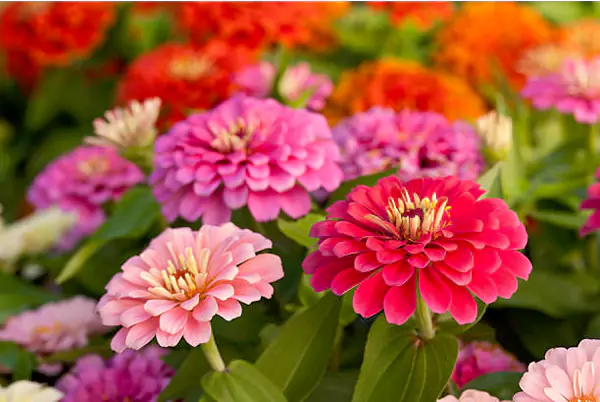
| Botanical Name: | Zinnia elegans |
| Sunlight Required: | Full sun |
| Hardiness Zones (USDA): | 3–10 |
| Blooming Period: | Summer |
| Preferred Soil: | Sandy, loamy |
The disc-shaped blossoms of Zinnia, which appear in a range of pink shades, are perfect for adding to wedding bouquets. They stand for lifelong friendship and lasting commitment. The delicate petals, born on branched stems, draw butterflies and bees but repel deer.
Maiden Pink
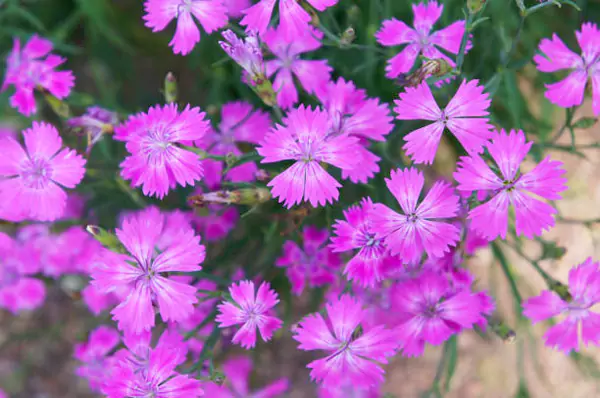
| Botanical Name: | Dianthus deltoides |
| Sunlight Required: | Full Sun |
| Hardiness Zones (USDA): | 3 – 10 |
| Blooming Period: | Late spring to summer |
| Preferred Soil: | Chalk, Loam, Sand |
Maiden Pink is a vigorous, evergreen perennial that spreads its slender, green leaves into a ground cover. It can be a great addition to rock gardens as it grows easily among pavement stones.
Abilene Early Large-Flowered Clematis
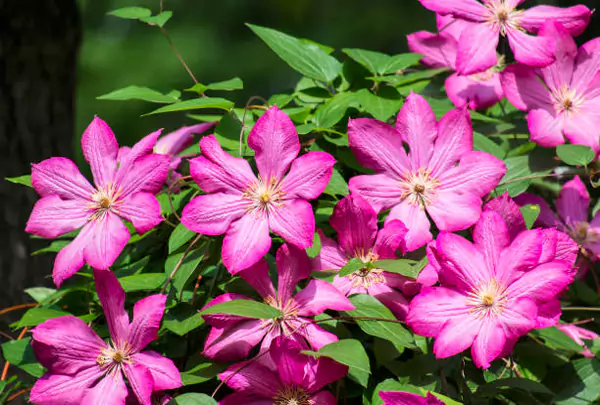
| Botanical Name: | Clematis ‘Abilene’ |
| Sunlight Required: | Full Sun, Partial Sun |
| Hardiness Zones (USDA): | 4 – 9 |
| Blooming Period: | Late spring to fall |
| Preferred Soil: | Moist but Well-Drained, Chalk, Clay, Loam, Sand |
This annual flower may grow up to 4 feet (1.22 m) tall, featuring gorgeous pink petals and elegantly ruffled leaves. It is advised to mulch the area surrounding the plant’s base to retain moisture and prevent the growth of weeds.
False Goat’s Beard
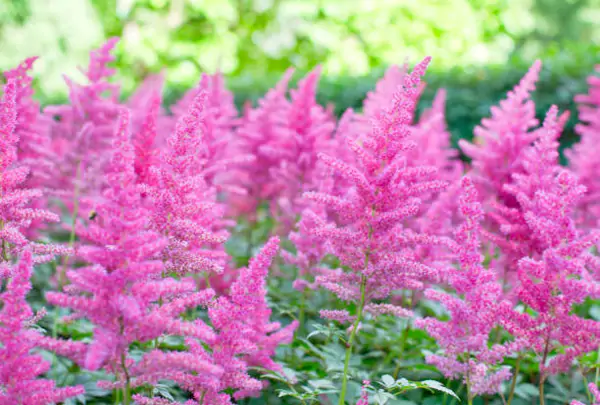
| Botanical Name: | Astilbe |
| Sunlight Required: | 3 – 9 |
| Hardiness Zones (USDA): | Full to partial shade |
| Blooming Period: | Mid to late summer |
| Preferred Soil: | Moist but Well-Drained, loam |
False goat’s beard, commonly called as Astilbe or Fake spirea, are prized for their cone-shaped, fluffy flowers. Their vibrant blooms fused with the delicious, fern-like leaves add a bright charm to the display.
Chenille
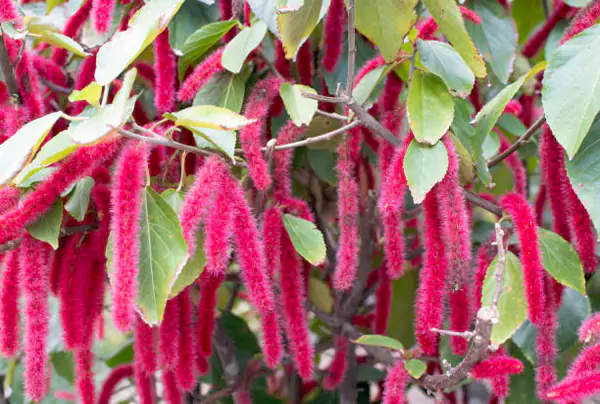
| Botanical Name: | Acalypha hispida |
| Sunlight Required: | Full Sun, Partial Sun |
| Hardiness Zones (USDA): | 10 – 11 |
| Blooming Period: | Throughout year |
| Preferred Soil: | Moist but Well-Drained, Chalk, Clay, Sand |
The velvety blossoms of Chenille, sometimes called monkey tail or red-hot cattail, often appear as hanging worms. After they flower, trim the branches to promote fresh growth and preserve a compact shape.
Lilac Bush
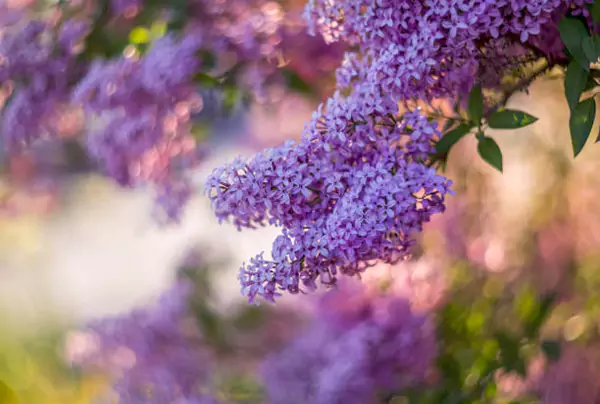
| Botanical Name: | Syringa reticulata |
| Sunlight Required: | Full sun |
| Hardiness Zones (USDA): | 3 – 8 |
| Blooming Period: | Mid-spring |
| Preferred Soil: | Moist but well-drained organic soil |
The vivid colors and strong scents of these deciduous plants set them apart in the landscape. The most popular hues for lilac bushes range from pinkish, lilac, and purple tones.
‘Dark Eyes’ Fuchsia
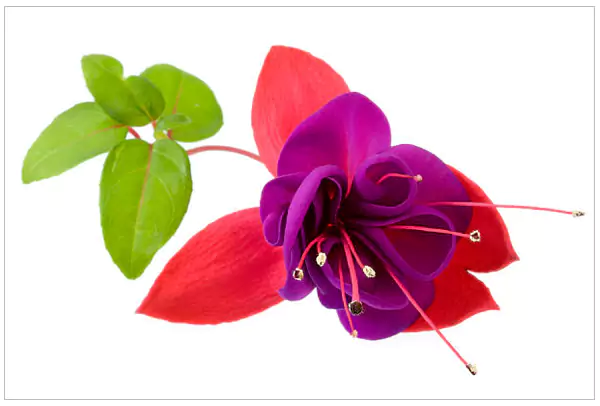
| Botanical Name: | Fuchsia hybrid ‘Dark Eyes’ |
| Sunlight Required: | Full-partial sun |
| Hardiness Zones (USDA): | 9 – 11 |
| Blooming Period: | Spring to fall |
| Preferred Soil: | Moist, fertile, well-drained soil |
This annual flower’s distinctive blossoms, resembling draped lanterns, make it an absolute star in outdoor settings. Usually placed in hanging pots, this shrub produces a unique red and magenta blooms.
Hyssop
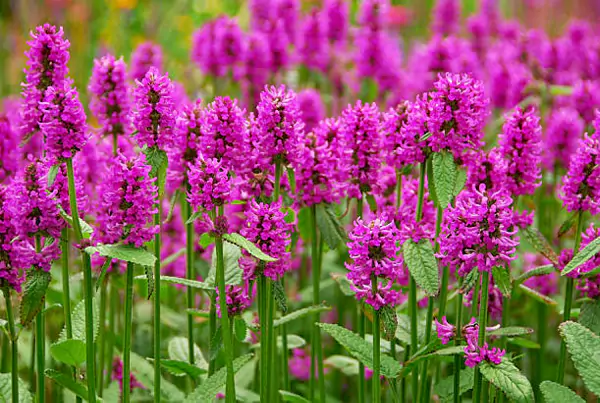
| Botanical Name: | Hyssopus officinalis |
| Sunlight Required: | Full sun |
| Hardiness Zones (USDA): | 3-9 |
| Blooming Period: | Mid-summer to late autumn |
| Preferred Soil: | Well-draining, fertile loamy soil |
Originating from Southern Europe, hyssop was widely used as a medicinal and cleansing tea from the seventh century. This ancient plant, besides being beautiful, can treat a wide range of conditions, including head lice and dyspnea.
Gaura
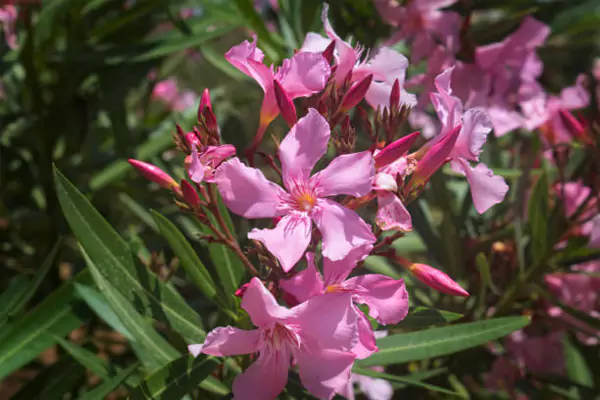
| Botanical Name: | Oenothera lindheimeri |
| Sunlight Required: | Full sun |
| Hardiness Zones (USDA): | 5 – 9 |
| Blooming Period: | Early summer into fall |
| Preferred Soil: | Sandy, loamy, well-draining soil |
Gaura is a nectar-rich flowering plant with pale pink veins running through its petals. Being highly low-maintenance, it needs little fertilizer to grow up to 15 to 48 inches long. However, to encourage regular blooming, deadhead wilted blossoms.
Camellia
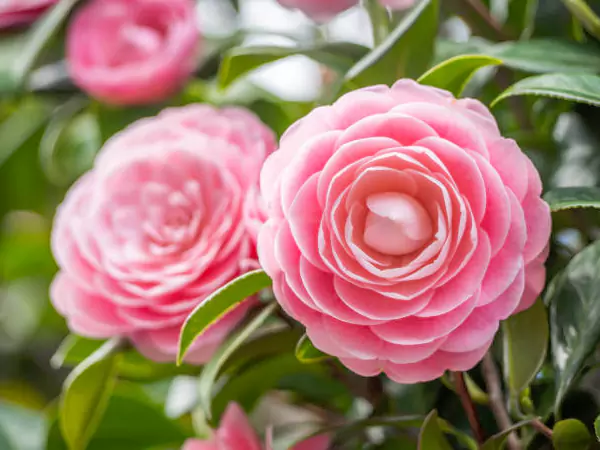
| Botanical Name: | Camellia japonica |
| Sunlight Required: | Partial-full shade |
| Hardiness Zones (USDA): | 7 – 10 |
| Blooming Period: | Fall to spring |
| Preferred Soil: | Well-drained, organic soil |
Camellia is a lush evergreen shrub featuring glossy green foliage and bulbous blooms. It produces lavishing multi-layered flowers in a multitude of colors, with the most popular being pink, yellow, and white.
Pink Firecracker Flower
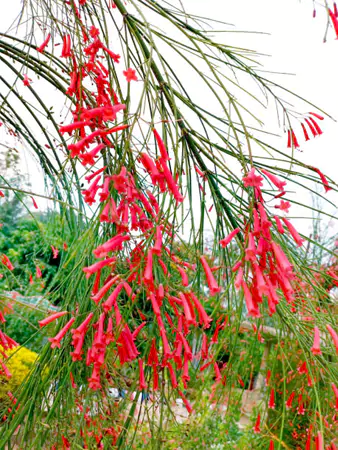
| Botanical Name: | Crossandra infundibuliformis |
| Sunlight Required: | Partial sun |
| Hardiness Zones (USDA): | 2 – 10 |
| Blooming Period: | Mid-summer to fall |
| Preferred Soil: | Well-drained, loamy soil |
The firecracker flower, resembling tiny firecrackers, blooms in a tubular shape hanging off grass-like stems. Its striking visuals with a lovely aroma easily attract butterflies and bees to the gardens from summer to fall.
Ivy Geranium

| Botanical Name: | Pelargonium peltatum |
| Sunlight Required: | Full-partial sun |
| Hardiness Zones (USDA): | 10 – 11 |
| Blooming Period: | Throughout the year |
| Preferred Soil: | Well-drained, loamy, or sandy soil |
This trailing geranium produces pale pink blooms with a pronounced darker tone across its petals. Their cascading branches combined with the clusters of blooms lend a sense of grace and elegance to any garden.
Lenten Rose
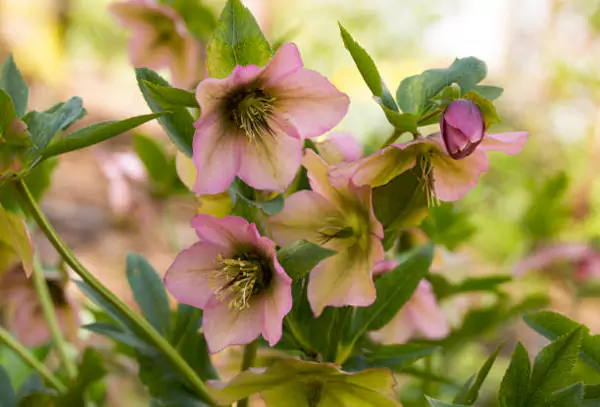
| Botanical Name: | Helleborus orientalis |
| Sunlight Required: | Partial-full sun |
| Hardiness Zones (USDA): | 5 – 9 |
| Blooming Period: | Winter to spring |
| Preferred Soil: | Well-drained, humus-rich garden soil |
Lenten rose is a popular flower of the genus Helleborus that comes in varying shades and tones. Pink Lenten Rose, often known by Helleborus ‘Paris in Pink’, is often picked by florists to add in an elegant pink hue to their flower arrangements.
Pink Nasturtium
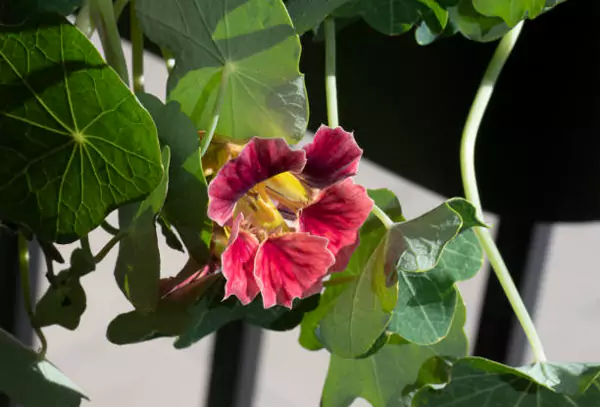
| Botanical Name: | Tropaeolum |
| Sunlight Required: | Full sun |
| Hardiness Zones (USDA): | 9 – 11 |
| Blooming Period: | Spring to fall |
| Preferred Soil: | Loamy or sandy soil |
Nasturtium is a beautiful bloom with just as stunning foliage. The funnel-shaped flowers highly contrast with the leaves that resemble lily pads in a pond. Looking at this plant, you will surely recall the story of the Frog prince.
Verbena
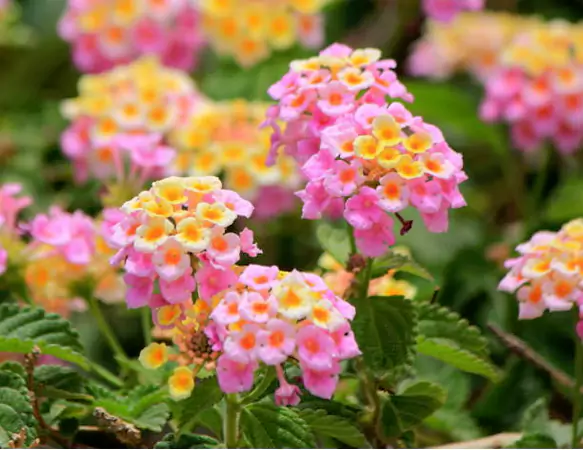
| Botanical Name: | Verbena |
| Sunlight Required: | Full to partial sun |
| Hardiness Zones (USDA): | 8-11 |
| Blooming Period: | Late spring to early fall |
| Preferred Soil: | Well-draining, slightly acidic soil |
Verbena, native to Asia and North America, blooms all summer long in delicate clusters of small pink and yellow blossoms. These dual-toned genus has roughly 250 species, both annual and perennial, in varying color combinations.
Impatiens
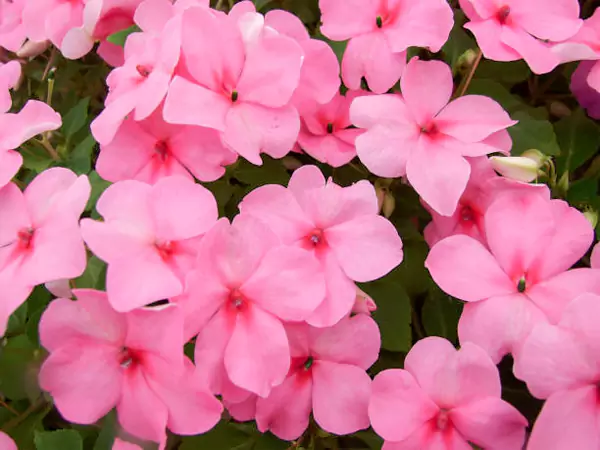
| Botanical Name: | Impatiens |
| Sunlight Required: | Partial sun |
| Hardiness Zones (USDA): | 10 – 11 |
| Blooming Period: | Late spring until first frost |
| Preferred Soil: | Humus-rich, moist but well-drained soil |
Impatiens is a huge genus offering a variety of compact, colorful flowers suitable as border plants. They can easily provide a vibrant and colorful accent to shaded areas, making them highly versatile and attractive.
Cosmos
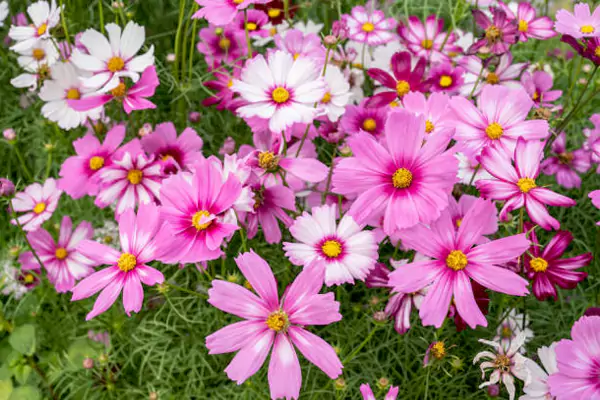
| Botanical Name: | Cosmos |
| Sunlight Required: | Full Sun |
| Hardiness Zones (USDA): | 2 – 11 |
| Blooming Period: | Early to mid-summer |
| Preferred Soil: | Dry, arid soil |
With a name denoting the starry universe, this flower sure does bring a galaxy of pink stars in your garden. These pinwheel blossoms come in an array of colors such as white, yellow, red, orange and different shades of pink.
Aster

| Botanical Name: | Aster |
| Sunlight Required: | Full-partial sun |
| Hardiness Zones (USDA): | 3 – 8 |
| Blooming Period: | Late summer to early fall |
| Preferred Soil: | Slightly acidic, loamy soil |
Aster is a flowering genus consisting of nearly 200 perennials. Each species boasts attractive foliage and daisy-like blooms, attracting bees and butterflies while adding grace to the landscape.
Moss Phlox ‘Pink’
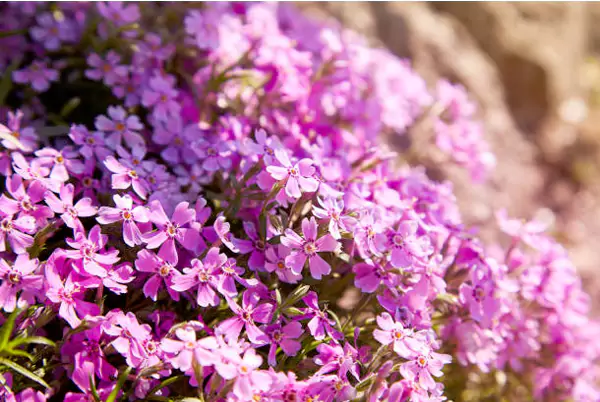
| Botanical Name: | Phlox subulata |
| Sunlight Required: | Full sun/Partial shade |
| Hardiness Zones (USDA): | 3 – 9 |
| Blooming Period: | Early spring |
| Preferred Soil: | Moist, well-drained, humus soils |
Moss Phlox ‘pink’ produces a lush groundcover of pink little flowers blooming on short stems. Just like original moss, they can easily spread across a vast area of land with little to no efforts.
Amaryllis
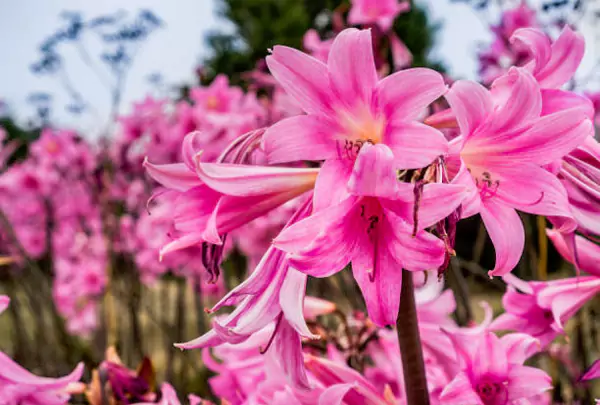
| Botanical Name: | Amaryllis |
| Sunlight Required: | Partial sun |
| Hardiness Zones (USDA): | 7 – 8 |
| Blooming Period: | Early spring |
| Preferred Soil: | Well-draining, acidic soil |
Although these magnificent flower blooms are a rare sight, it is still everyone’s favorite for its distinct petal structure. The trumpet-shaped flowers of the Amaryllis are placed atop a leafless stain that can grow to a height of two feet.
Lupine
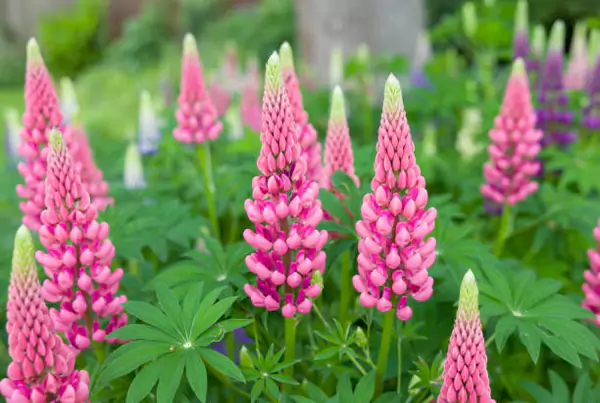
| Botanical Name: | Lupinus |
| Sunlight Required: | Full sun |
| Hardiness Zones (USDA): | 3 – 9 |
| Blooming Period: | Late spring to summer |
| Preferred Soil: | Rich, well-drained, slightly acidic soil |
These gorgeous blooms can reach a height of 5 feet and come in a variety of colors, such as pink, blue, and purple. They make a wonderful focal point for a patio area in a garden or a backdrop for smaller plants.
Periwinkle

| Botanical Name: | Catharanthus roseus |
| Sunlight Required: | Partial-full sun |
| Hardiness Zones (USDA): | 4 – 9 |
| Blooming Period: | Spring to frost |
| Preferred Soil: | Well drained, slightly acidic soil |
Because of its short stature, periwinkle is a top destination among planters to contrast the taller plants. This quick-growing plant come in an array of colors including blue, purple, and shades of pink.
Forget-me-not
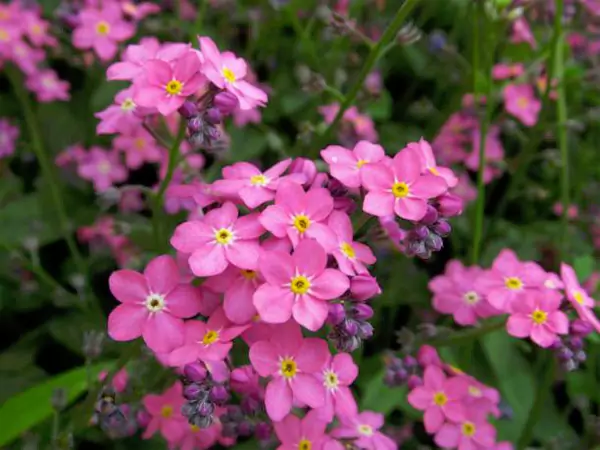
| Botanical Name: | Myosotis |
| Sunlight Required: | Full sun |
| Hardiness Zones (USDA): | 3 – 8 |
| Blooming Period: | Late spring to early summer |
| Preferred Soil: | Rich moist soil |
This plant is often grown in gardens for its easy nature, low maintenance needs, and gentle beauty. Its name comes from a story about ancient warriors who wore it to make sure their partner would remember them while they’re away.
Columbine

| Botanical Name: | Aquilegia |
| Sunlight Required: | Full-partial shade |
| Hardiness Zones (USDA): | 3 – 9 |
| Blooming Period: | Late spring to early summer |
| Preferred Soil: | Loamy or sandy soil |
Columbine flowers, known for their gentle nature and resistance to varying conditions, are perfect for beginners to grow. With their sweet fragrance, they easily attract hummingbirds and other pollinators.
Pink Daisy
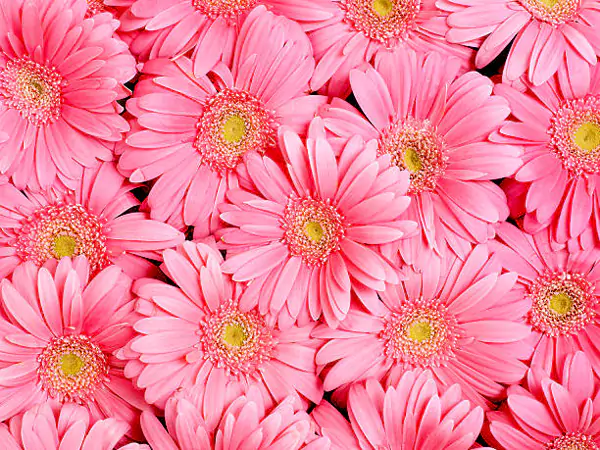
| Botanical Name: | Bellis |
| Sunlight Required: | Full sun |
| Hardiness Zones (USDA): | 5 – 8 |
| Blooming Period: | Late fall |
| Preferred Soil: | Rich, fast-draining soil |
With their blushy pink petals, Daisies are a classic choice for gardeners worldwide. With a huge array of colors, ranging from pink, white and yellow, it is suitable for any floral arrangement, bordering, or cutting gardens.
Thyme
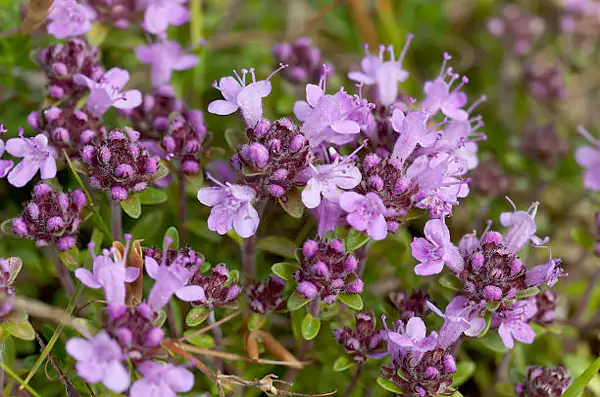
| Botanical Name: | Thymus vulgaris |
| Sunlight Required: | Full Sun |
| Hardiness Zones (USDA): | 2 – 10 |
| Blooming Period: | Spring to summer |
| Preferred Soil: | Well-drained, alkaline, soil |
Thyme is an excellent herb often added to cooking recipes and tea, grown as a ground cover alongside pathways and defining borders, making it an excellent choice for garden designs.
Pink Geranium
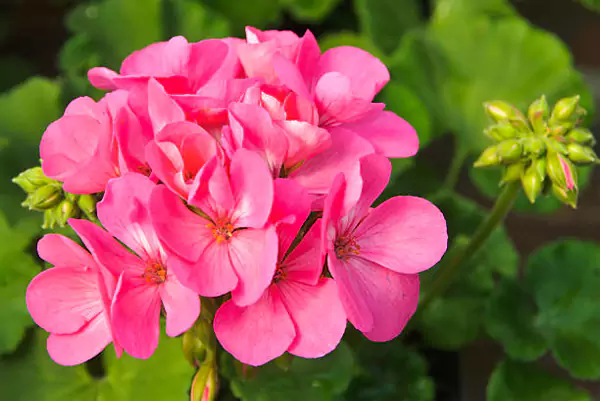
| Botanical Name: | Pelargonium |
| Sunlight Required: | Full Sun |
| Hardiness Zones (USDA): | 3 – 9 |
| Blooming Period: | Throughout spring |
| Preferred Soil: | Well-drained organic soil |
Geraniums bloom vibrantly in early spring, providing a touch of elegance and charm to gardens. Available in various colors, they are perfect for borders, containers, or window boxes, making them a favorite among gardeners.
Delphinium
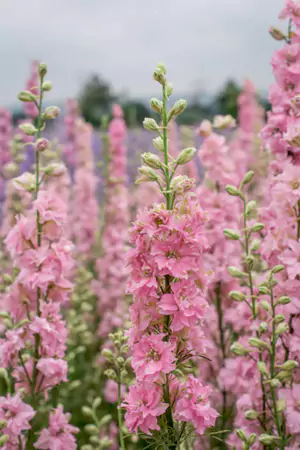
| Botanical Name: | Delphinium |
| Sunlight Required: | Full Sun |
| Hardiness Zones (USDA): | 3 – 7 |
| Blooming Period: | Early summer to early fall |
| Preferred Soil: | Moist but well-drained, neutral soil |
Delphiniums are towering and delicate plants, ideal for indoor vase decorations and cut flowers. With their delicate pink blossoms and finely cut foliage, they will easily highlight your garden.
Oriental Lily

| Botanical Name: | Lilium ‘Stargazer’ |
| Sunlight Required: | Full to partial sun |
| Hardiness Zones (USDA): | 6-9 |
| Blooming Period: | Mid to late summer |
| Preferred Soil: | Moist but well-drained, acidic soil |
Oriental lilies, known for their beauty and elegance, are ideal for border flowers, containers, and cut flowers. While being a low-maintenance, easy-to-grow plant, they attract pollinators and contribute to long-lasting flower arrangements.
African Violet
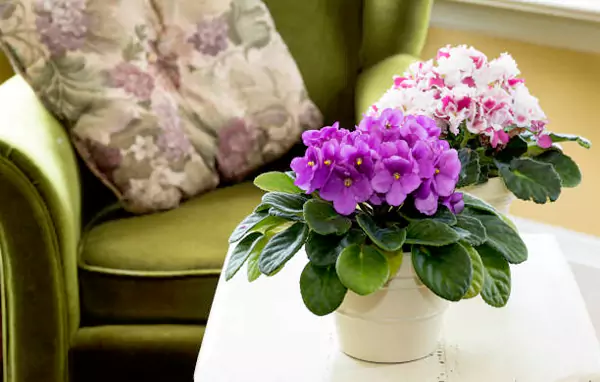
| Botanical Name: | Saintpaulia |
| Sunlight Required: | Partial shade |
| Hardiness Zones (USDA): | 3 – 9 |
| Blooming Period: | Throughout the year |
| Preferred Soil: | Well-drained, slightly acidic soil |
African violets, are small edible plants, perfect for indoors and rock gardens. Their fragrant blooms and lush green foliage add elegance and nostalgia, making them ideal for homemade dishes and adding a touch of nostalgia.
Bergenia
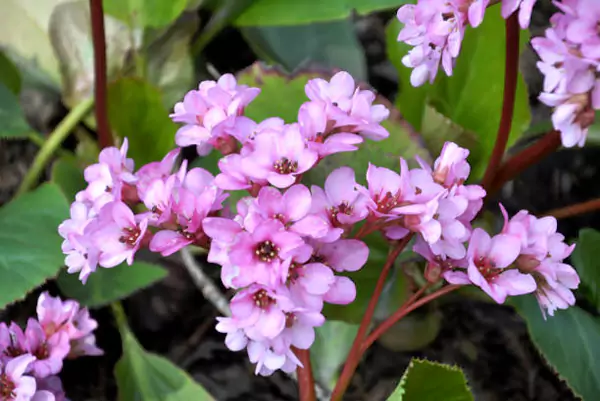
| Botanical Name: | Bergenia |
| Sunlight Required: | Partial Sun |
| Hardiness Zones (USDA): | 5 – 8 |
| Blooming Period: | Winter through spring |
| Preferred Soil: | Moist organic soil |
During winter, the thick, glossy leaves of Bergenias, add structure and boldness to gardens. These plants, with their puffy pink rosettes, spread slowly, making them a popular ground cover, ideal for borders, ground covers, and rock garden.
Trifolium Rubens
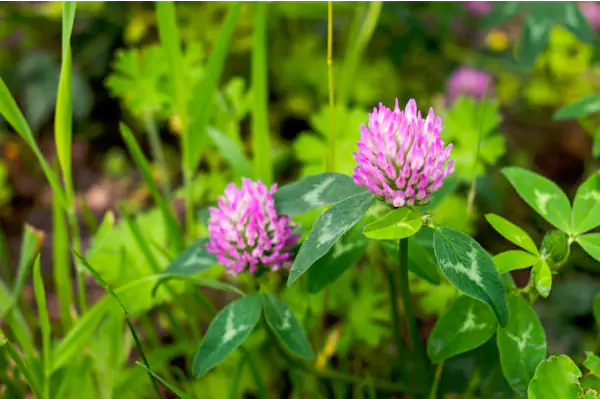
| Botanical Name: | Trifolium rubens |
| Sunlight Required: | Full-partial sun |
| Hardiness Zones (USDA): | 3 – 8 |
| Blooming Period: | Throughout summer |
| Preferred Soil: | Well-drained soil with a mix of perlite |
Trifolium Rubens, despite being a wild flower, is a popular choice for its pretty blooms. Its ravishing bulb attracts pollinators, making it ideal for borders, rock gardens, or wildflower meadows.
Sea Thrift
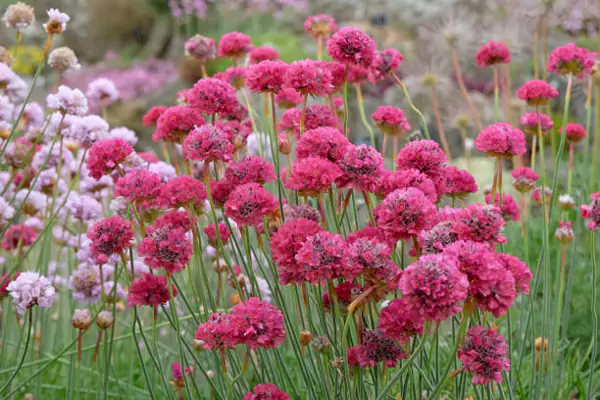
| Botanical Name: | Armeria maritima |
| Sunlight Required: | Full sun |
| Hardiness Zones (USDA): | 3 – 10 |
| Blooming Period: | Mid spring to summer |
| Preferred Soil: | Very well-drained, slightly dry soil |
Sea thrift is an easy-to-grow plant suitable for rocky foundations and coastal gardens. Its soft, tufted clusters of pink blooms and grass-like foliage make it a perfect addition to flower beds and garden borders.
Turtlehead
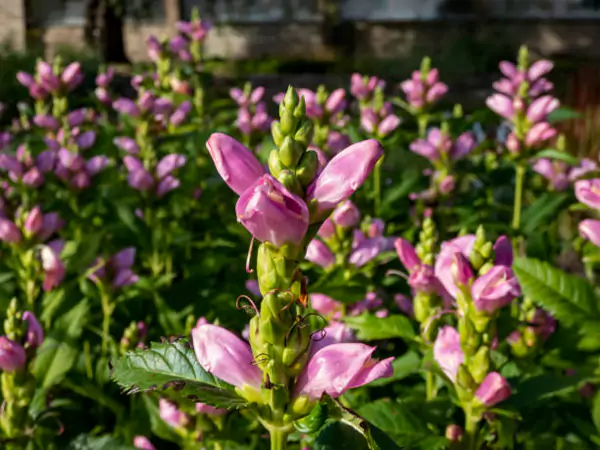
| Botanical Name: | Chelone |
| Sunlight Required: | Partial sun |
| Hardiness Zones (USDA): | 3 – 9 |
| Blooming Period: | Mid summer to fall |
| Preferred Soil: | Moist, neutral soil |
The unique Turtlehead flower is a great addition to woodland gardens, lending a charming and unique flair to your garden. This plant thrives in muddy, swampy area that receives morning light with afternoon shade.
Coneflower
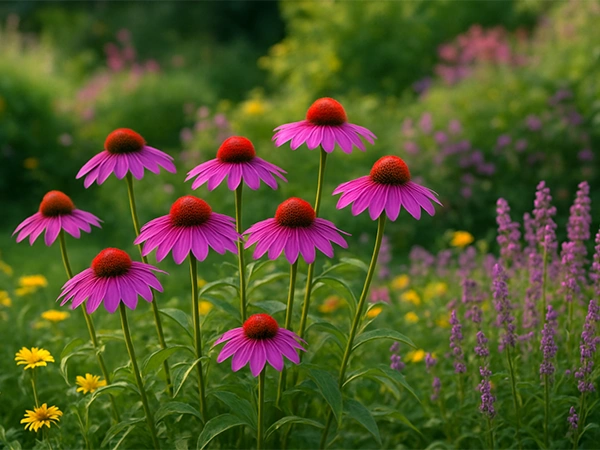
| Botanical Name: | Echinacea |
| Sunlight Required: | Full-partial sun |
| Hardiness Zones (USDA): | 5 – 8 |
| Blooming Period: | Mid to late summer |
| Preferred Soil: | Rich, rocky, clay or sandy soil |
The Coneflower, with prominent pink blossoms, adds a splash of color to your garden. Its high-temperature and drought-tolerant nature makes it an excellent choice for borders, cottage gardens, or cut flowers.
Crabapple Tree

| Botanical Name: | Malus |
| Sunlight Required: | Full Sun |
| Hardiness Zones (USDA): | 4 – 8 |
| Blooming Period: | Throughout spring |
| Preferred Soil: | Rich, slightly acidic soil |
The Crabapple Tree, tall and vibrant, transforms into a focal point in any garden. It grows best when exposed to full sun and can reach 25 feet tall, attracting pollinators and providing a stunning display of color.
Anemone
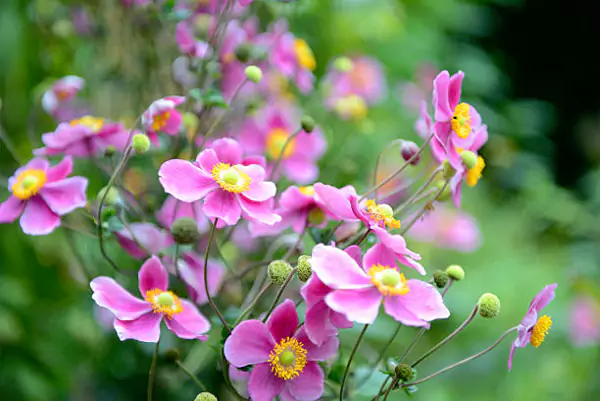
| Botanical Name: | Anemone |
| Sunlight Required: | Partial sun |
| Hardiness Zones (USDA): | 4 – 9 |
| Blooming Period: | Early spring through fall |
| Preferred Soil: | Moist but well-drained, slightly acidic soil |
Anemones symbolize spiritual peace and luck, enhancing woodland gardens with their beautiful cup-shaped pink flowers and fern-like foliage, adding a touch of sophistication and love.
Veronica
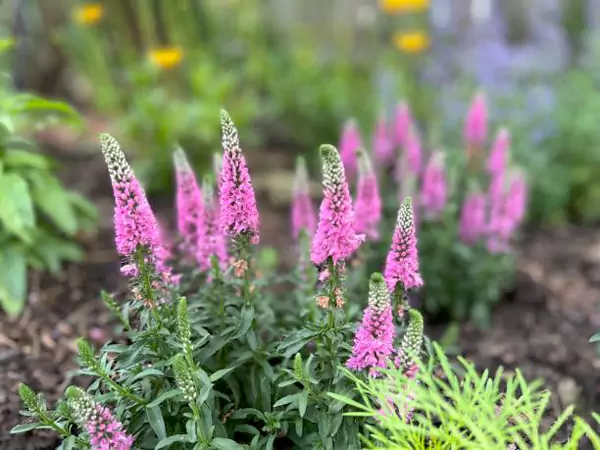
| Botanical Name: | Veronica |
| Sunlight Required: | Full sun |
| Hardiness Zones (USDA): | 3 – 11 |
| Blooming Period: | Spring through fall |
| Preferred Soil: | Well-drained, loamy soil |
Veronicas, with their wide range of colors and lance-shaped foliage, are perfect for small gardens. Their spiky clusters of pink blossoms add structure and color, making them ideal for borders, rock gardens, or edging plants.
Marsh Orchids
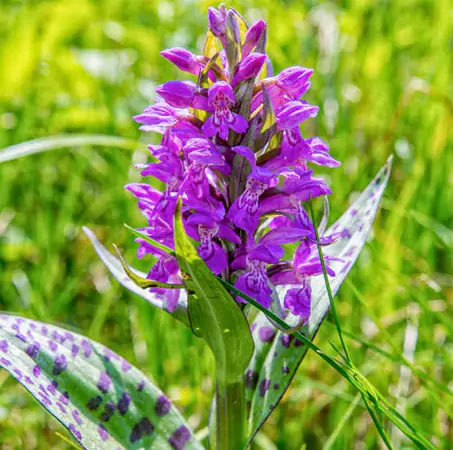
| Botanical Name: | Dactylorhiza |
| Sunlight Required: | Full-partial sun |
| Hardiness Zones (USDA): | 5 – 8 |
| Blooming Period: | Late spring to early summer |
| Preferred Soil: | Loam mixed with peat or grit. |
Marsh orchid is a stunning wild flower that features low-growing foliage and a long stem covered in gorgeous flower crowns. Being highly resistant to environmental changes, it is a great low-maintenance plant.
Hellebore
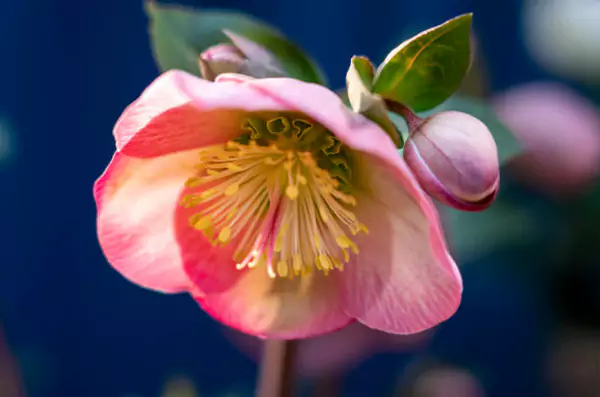
| Botanical Name: | Helleborus |
| Sunlight Required: | Partial to full shade |
| Hardiness Zones (USDA): | 3-9 |
| Blooming Period: | Early spring to summer |
| Preferred Soil: | Well-draining soil |
Since Hellebores love shade, you can plant them in any part of your garden that isn’t exposed to direct sunlight. ‘Flower Girl’ a variety having ruffled pink flowers with dark pink tips, is often chosen for flower arrangements.
Coral Bells
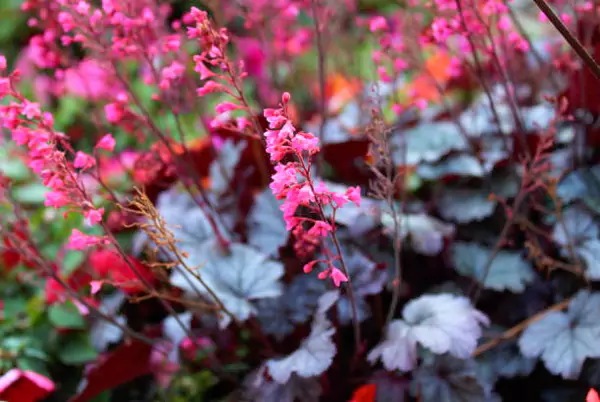
| Botanical Name: | Heuchera |
| Sunlight Required: | Full to partial sun |
| Hardiness Zones (USDA): | 3-10 |
| Blooming Period: | Late spring through summer |
| Preferred Soil: | Rich, well-drained soil |
Given the adaptable nature of coral bells, these gorgeous blooms can fit in every corner of your yard. The tiny pink bulbs hanging from the top of long stalks highly contrasts with its funky silver leaves.
Swamp Milkweed
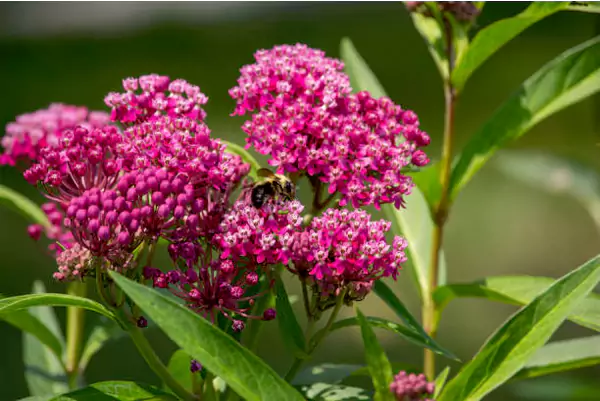
| Botanical Name: | Asclepias incarnata |
| Sunlight Required: | Partial shade |
| Hardiness Zones (USDA): | 3-9 |
| Blooming Period: | Mid spring to early fall |
| Preferred Soil: | Moist to wet soil |
Native to North America, Swamp milkweed fosters fragrant, pink-hued cluster blooms, being a vital habitat and food for pollinators. As the name suggests, it grows in swamps, marshes, wetlands, and the areas around streams and ponds.
Weigela
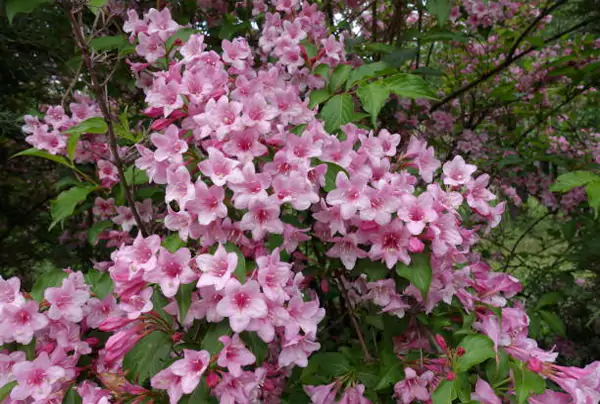
| Botanical Name: | Weigela florida |
| Sunlight Required: | Full sun |
| Hardiness Zones (USDA): | 4-8 |
| Blooming Period: | Late spring to early summer |
| Preferred Soil: | Well-drained, moist soil |
A lovely deciduous shrub, Weigela is a stunning flower that brings butterflies and hummingbirds to your yard. It will be a pollinator’s paradise when they bloom in the spring.
Wild Bleeding Heart
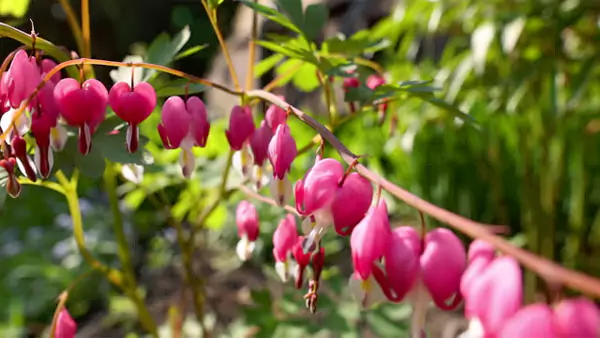
| Botanical Name: | Dicentra eximia |
| Sunlight Required: | Partial shade |
| Hardiness Zones (USDA): | 4-8 |
| Blooming Period: | Late spring to early summer |
| Preferred Soil: | Moist, humus soil |
Wild bleeding hearts thrive in shadows, with pink tubular-shaped hanging blooms that resemble hearts. Their delicately cut, fern-like leaves give the garden a subtle feel while adding a pop of bright pink.
Joe Pye Weed

| Botanical Name: | Eupatorium maculatum |
| Sunlight Required: | Full to partial sun |
| Hardiness Zones (USDA): | 4-9 |
| Blooming Period: | Late summer to winter |
| Preferred Soil: | Moist but well-drained, Clay/loam/sand |
This architectural perennial is known for its large clusters of pink flowers, ideal for the rear of a border. The flowers attract bees and butterflies looking for nectar while producing fluffy seedheads for birds to feed on.
Peruvian Lily

| Botanical Name: | Alstroemeria |
| Sunlight Required: | Full to partial sun |
| Hardiness Zones (USDA): | 8-10 |
| Blooming Period: | Late spring to early fall |
| Preferred Soil: | Well-drained, acidic |
These beautiful six-petaled lilies are a favorite of many florists to add to a floral arrangement. Originating in South America, the Peruvian lily is distinguished by its varying pink shades. Plus, the yellow gold center combined with tiger-like stripes greatly accentuates the petals.
Lisianthus
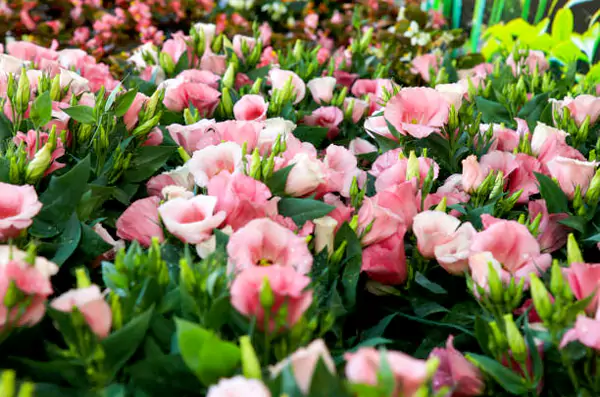
| Botanical Name: | Eustoma |
| Sunlight Required: | Full to partial sun |
| Hardiness Zones (USDA): | 8-10 |
| Blooming Period: | Early summer to early fall |
| Preferred Soil: | Well-drained, neutral soil |
Although growing this well-liked flower can be challenging, the reward of its gorgeous bouquet blooms is well worth the work! Living in a warm climate, you can easily plant these layered blooms in shades of pink, purple, white, or cream.
Ornamental Allium
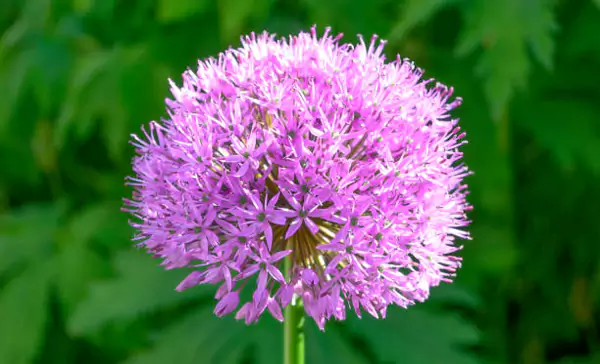
| Botanical Name: | Allium ‘Serendipity’ |
| Sunlight Required: | Full to partial sun |
| Hardiness Zones (USDA): | 4-8 |
| Blooming Period: | Mid to late summer |
| Preferred Soil: | Moist but well-drained, clay/loam/sand |
These perennials are borne atop sturdy, upright stems boasting globe-shaped, rosy-pink flowers. The flowers are rich in nectar, drawing butterflies and bees, while the foliage exudes a faint onion-like smell.
Bougainvillea
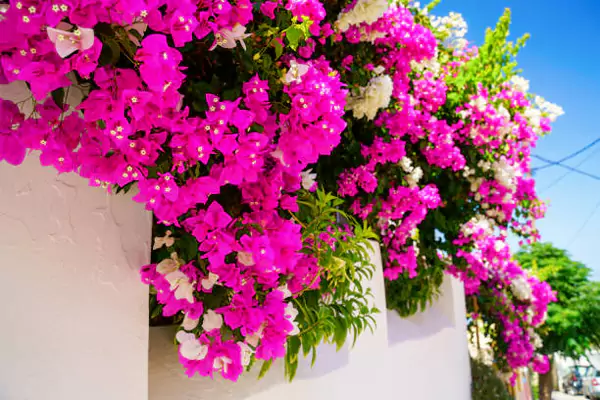
| Botanical Name: | Bougainvillea |
| Sunlight Required: | Full sun |
| Hardiness Zones (USDA): | 9-10 |
| Blooming Period: | Throughout the year |
| Preferred Soil: | Well drained, acidic soil |
This beautiful native of South America doesn’t have actual flowers. Instead, it features bright pink and magenta leaves which shield the tiny trumpet-shaped bloom. The colorful leaves often attract pollinators due to their vibrant pink tint.
Freesia
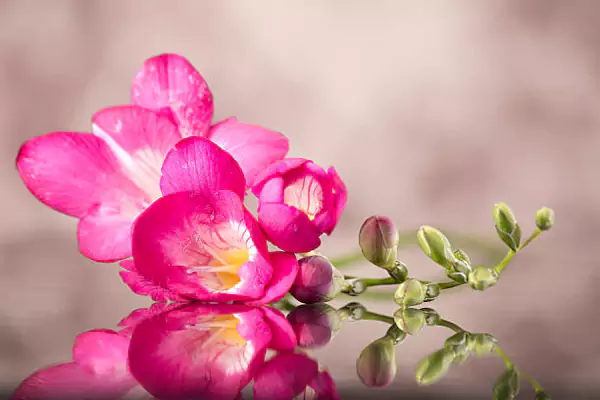
| Botanical Name: | Freesia |
| Sunlight Required: | Full to partial sun |
| Hardiness Zones (USDA): | 9-10 |
| Blooming Period: | Late winter to early spring |
| Preferred Soil: | Well-drained, neutral soil |
Freesia is popular in cutting gardens and bouquets for their delicate, lovely scent. Its delicate petals complement a wide range of colors, including several shades of pink. Symbolizing trust, they are a fantastic choice for wedding bouquets.
Gloriosa Lily
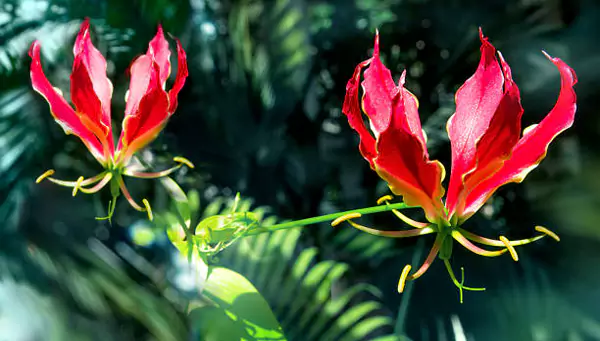
| Botanical Name: | Gloriosa |
| Sunlight Required: | Full sun |
| Hardiness Zones (USDA): | 8-10 |
| Blooming Period: | Mid-summer to fall |
| Preferred Soil: | Well-drained, slightly acidic soil |
Given their flame-like appearance, they’re often nicknamed ‘Flame Lilies’ or ‘Fire Lilies’. Plus, their flower structure topped off with unique stamens makes them appear as if they’re hanging in mid-air.
Knautia
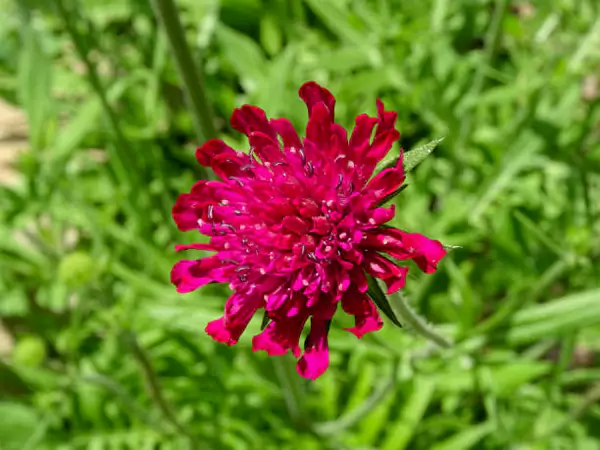
| Botanical Name: | Knautia |
| Sunlight Required: | Full sun |
| Hardiness Zones (USDA): | 5-9 |
| Blooming Period: | Early summer through fall |
| Preferred Soil: | Well-drained, neutral, or alkaline soil |
The pincushion-shaped flowers of the Knautia bloom in a range of pink hues, from light blush to deep crimson. Also known as widow flowers, these bulbs bloom on long, slender stems, that are highly drought tolerant.
Plumeria
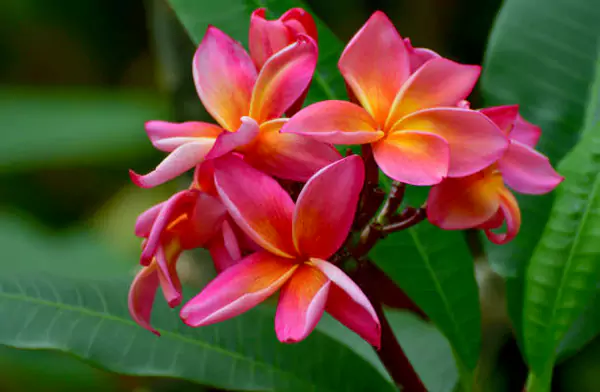
| Botanical Name: | Frangipani |
| Sunlight Required: | Full to partial sun |
| Hardiness Zones (USDA): | 10-12 |
| Blooming Period: | Late spring to fall |
| Preferred Soil: | Well-drained, cactus mix |
Plumeria features a unique pinwheel structure with a gradient of pink and yellow. This nectar-less flower often tricks sphinx moths and other pollinators with its sweet fragrance.
Moss Rose
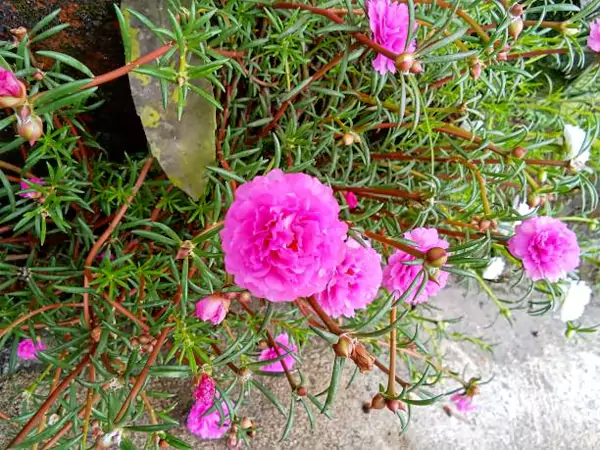
| Botanical Name: | Portulaca grandiflora |
| Sunlight Required: | Full sun |
| Hardiness Zones (USDA): | 2-11 |
| Blooming Period: | Summer to fall |
| Preferred Soil: | Well-drained, loam or sand |
Moss-rose purslane, a semi-succulent flowering plant, is available in a range of colors, including pink, yellow, and a pink-white hybrid. Their reddish stalks are fond of spreading out, taking over any available space.
Reaching the end of this list, you’ve discovered the multi-shaded realm of pink blossoms. Among these shades, light pink and hot magenta top the charts of being people’s favorite hues. In the upcoming sections, we’ve brought a catalog of flowers in both of these shadings.
Top Light Pink Flowers Names With Gardening Tips
In this section, let’s stroll through the list of light pink flowers that remain everyone’s favorites! We’ll also sneak a look at their spiritual meaning, hardy zones, and other gardening requirements.
Azalea
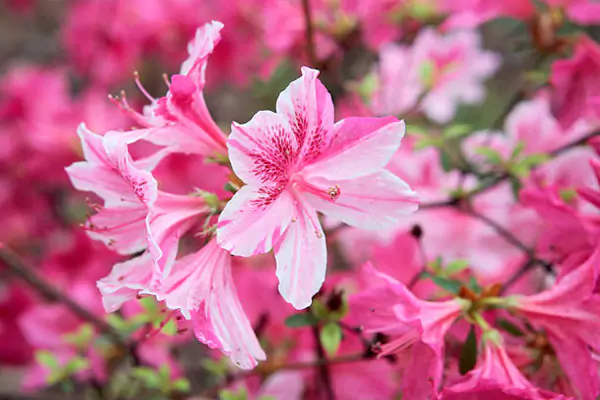
Roseshell Azalea is prized for its lovely smell and magnificent display. With showy, funnel-shaped petals, this shrub-like plant blossoms in mid-spring lasting till late spring. These are usually found in clusters of m4–12 with the flowers being 1-2 in. (2–5 cm) broad.
| Botanical Name | Rhododendron prinophyllum |
| Signifies | Femininity |
| Sunlight Required | Partial sun |
| Preferred Soil | Well-drained, loamy, or sandy soil |
| Hardiness Zones (USDA) | 3 to 9 |
| Blooming Period | Spring through summer |
Begonias

These fascinating blossoms, made up of 1,800 distinct species, are divided into three major groups: semperflorens (most common), tuberous, and perennials (uncommon). Besides the resemblance of roses, tuberous begonias also have edible leaves, stems, and flowers.
| Botanical Name | Begonia |
| Signifies | Being cautious |
| Sunlight Required | Partial sun |
| Preferred Soil | Well-drained, loamy, or sandy |
| Hardiness Zones (USDA) | 9 to 11 |
| Blooming Period | Spring through fall |
Butterfly Bush Pink Delight
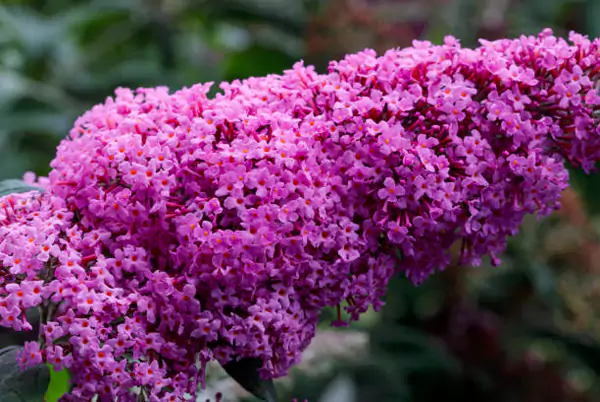
Due to its ability to lure butterflies in like a magnet, this gorgeous bloom was named Butterfly Bush. Little pink blooms cover medium- to large-sized bushes that are quick and easy to grow. Though most commonly found in lavender, the butterfly bush looks especially beautiful in shades of pink.
| Botanical Name | Buddleja davidii ‘Pink Delight’ |
| Signifies | Rebirth and New Beginnings |
| Sunlight Required | Full sun |
| Preferred Soil | Well-drained, loamy |
| Hardiness Zones (USDA) | 8+ |
| Blooming Period | Mid-summer through fall |
Cherry Blossom

These popular blossoms, native to Japan, were brought over as seedlings to the US in 1912. The feathery pink flowers usually bloom around April, filling the surroundings with a sweet scent. Given its aroma, this plant is also used as an ingredient in teas and drinks.
| Botanical Name | Prunus |
| Signifies | Beauty of life and spring |
| Sunlight Required | Full sun to shade |
| Preferred Soil | Well-drained, sandy |
| Hardiness Zones (USDA) | 5 to 8 |
| Blooming Period | Spring |
Dahlia
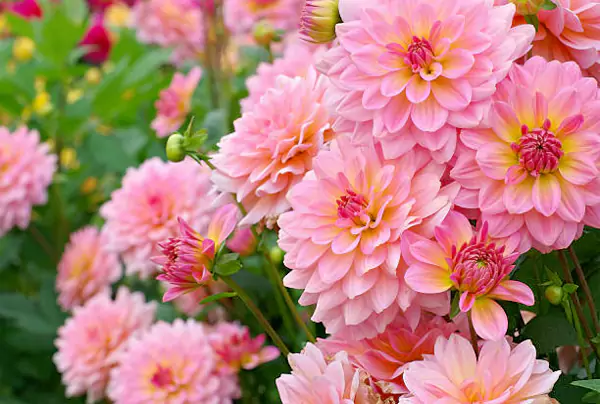
These buds, ranging up to 42 different species, originated in Mexico. The fun thing is that they are closely related to the chrysanthemums while being part of the Asteraceae family. Known for their unique curved-up structure, they have stunning petal layering structures.
| Botanical Name | Dahlia |
| Signifies | Grace and kindness |
| Sunlight Required | Full sun |
| Preferred Soil | Well-drained, rich loamy soil |
| Hardiness Zones (USDA) | 2 to 10 |
| Blooming Period | Late spring to early fall |
Hibiscus

These stunning pink flowers embody the lush tropical environment of their native regions surrounding the Pacific Rim. With a distinctive stamen, their aroma has grown to be a favorite scent in perfumes and a cherished flavor in recipes for multiple drinks and foods.
| Botanical Name | Hibiscus rosa-sinensis |
| Signifies | Beauty and femininity |
| Sunlight Required | Full sun |
| Preferred Soil | Well-drained, moist |
| Hardiness Zones (USDA) | 5+ |
| Blooming Period | Summer |
Hollyhock
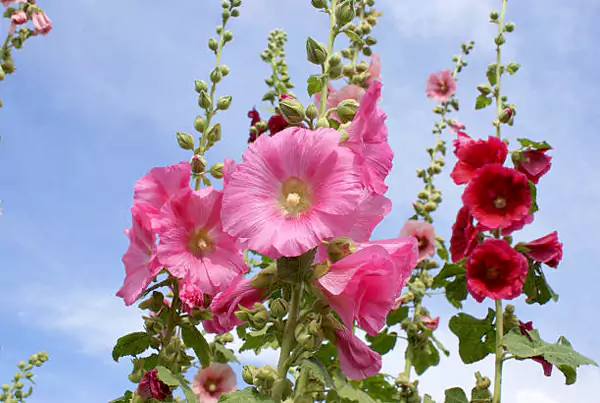
Growing on long stalks, the gorgeous hollyhock blossoms create a picture-perfect exterior for a home. Whether in a garden setting or on a trellis, they can grow elegantly without high maintenance. They are also a great choice for partitions when grown along a fence line.
| Botanical Name | Alcea rosea |
| Signifies | Fruitfulness and motherly love |
| Sunlight Required | Full sun |
| Preferred Soil | Well-drained, loamy |
| Hardiness Zones (USDA) | 3 to 8 |
| Blooming Period | Summer |
Pink Meadow Sweet
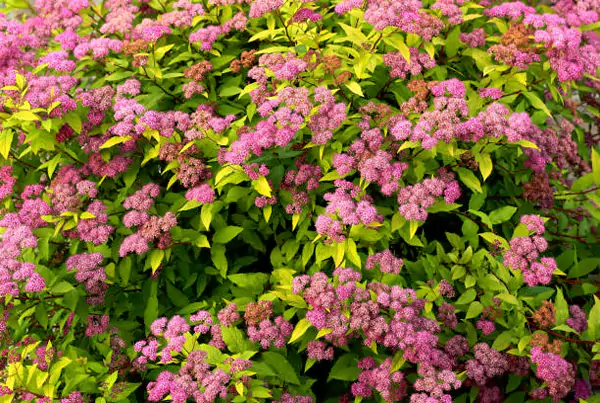
Delicate clusters of these exquisite pink flowers can reach three to seven feet. Given their enormous height and whimsical vibe, they are ideal for event decor. Meadow sweets are also often used medicinally to alleviate stomach problems and colds.
| Botanical Name | Filipendula rubra |
| Signifies | Courtship |
| Sunlight Required | Partial Sun |
| Preferred Soil | Well-drained |
| Hardiness Zones (USDA) | 3 to 8 |
| Blooming Period | Summer to early fall |
Petunia
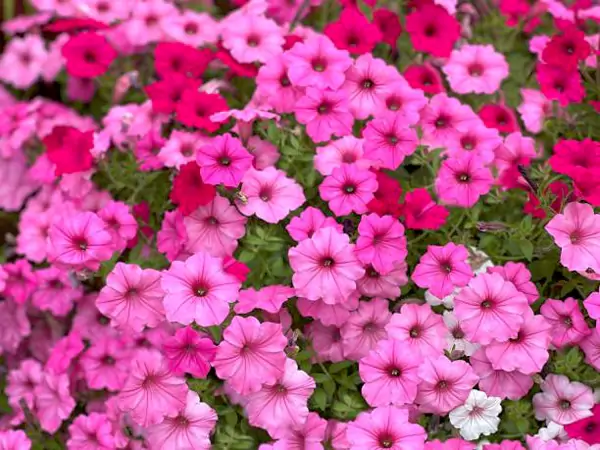
Petunias come in a broad range of colors and lovely patterns, with pink being the most popular hue. These flowers are native to South America and make excellent ground cover as they are sufficiently short and grow nicely in containers.
| Botanical Name | Petunia |
| Signifies | Longing or anger |
| Sunlight Required | Full sun |
| Preferred Soil | Fast-draining |
| Hardiness Zones (USDA) | All |
| Blooming Period | Summer to mid-fall |
Pink Rose
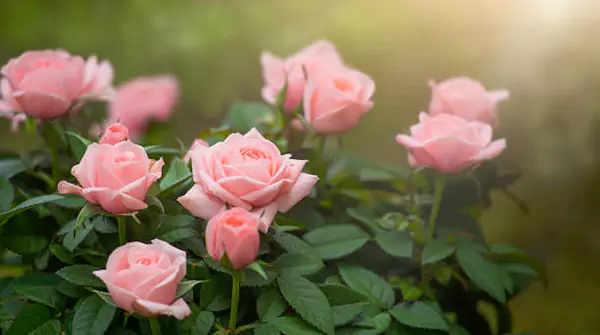
Roses are known to be a timeless symbol of beauty and love, yet each hue has a distinct meaning. Pink roses are a symbol of adoration and blooming admiration, making them a popular choice for confessions and anniversaries. Roses bloom intermittently from mid-spring to autumn. To maintain optimal growth, trimming is necessary.
| Botanical Name | Rosa |
| Signifies | Appreciation and admiration |
| Sunlight Required | Full to partial sun |
| Preferred Soil | Well-drained |
| Hardiness Zones (USDA) | 7+ |
| Blooming Period | Mid-spring to fall |
Spider Lily
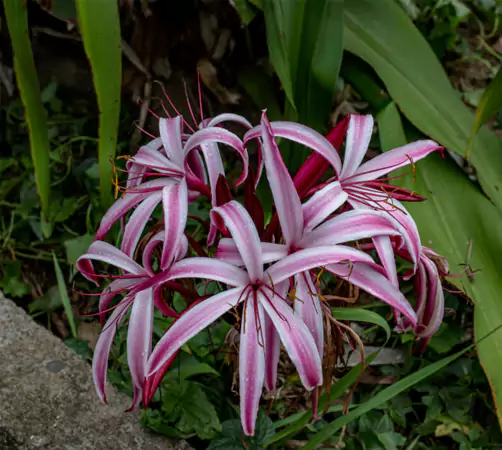
The name Spider Lily comes from the formation of their petal structure, which consists of long, thin stamen resembling a spider’s legs. Their long stems lack proper leaves; instead, they have small leaf buds. These plants can be toxic to animals; thus, keep them out of the reach of your pets.
| Botanical Name | Lycoris |
| Signifies | Afterlife |
| Sunlight Required | Partial sun |
| Preferred Soil | Well-drained, loamy, or sandy |
| Hardiness Zones (USDA) | 4 to 11 |
| Blooming Period | Late summer to fall |
Pink Hyacinth
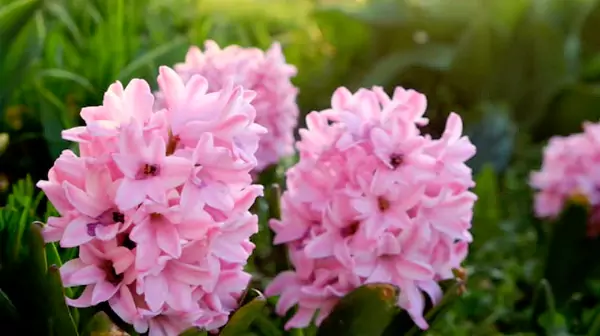
Originating in the Mediterranean area, hyacinths reached their peak of popularity during the Victorian era. Hyacinth bulbs must be planted in the autumn for a spring bloom. However, gloves should be used when handling these bulbs, as they contain toxic elements. Pets should also be kept away from them.
| Botanical Name | Hyacinthus |
| Signifies | Playfulness |
| Sunlight Required | Partial sun |
| Preferred Soil | Well-drained, loamy, or sandy |
| Hardiness Zones (USDA) | 4 to 9 |
| Blooming Period | Early to mid-spring |
Pink Tulips
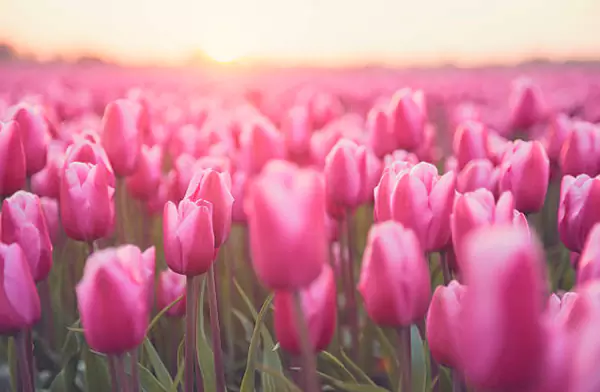
Tulips are a lovely representation of true love and affection. They bloom from late March to mid-May, making them a fantastic choice for Mother’s Day and other spring celebrations like Easter. In Holland, tulips fill the ground, a breathtaking phenomenon that solely draws tourists from all over the world.
| Botanical Name | Tulipa |
| Signifies | Caring and endearment |
| Sunlight Required | Full to partial sun |
| Preferred Soil | Well-drained, loamy |
| Hardiness Zones (USDA) | 4 to 10 |
| Blooming Period | Spring |
Carnation
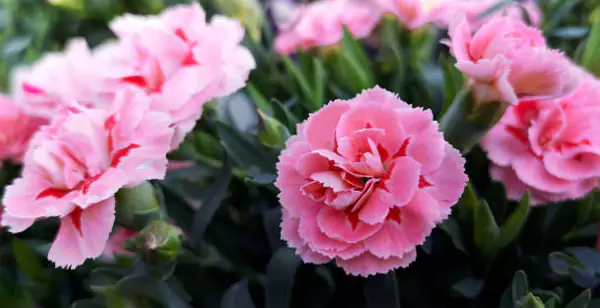
Pinks and purples are known to be the natural shades of a carnation flower. However, with selective breeding, they are now available in multiple other colors, such as red, white, orange, green, and blue. The petals of these blooms are often used to garnish dishes as well.
| Botanical Name | Dianthus caryophyllus |
| Signifies | Gratitude and being unforgettable |
| Sunlight Required | Partial sun |
| Preferred Soil | Well-drained, fertilized |
| Hardiness Zones (USDA) | 3 to 10 |
| Blooming Period | Late spring through summer |
Pink Wisteria
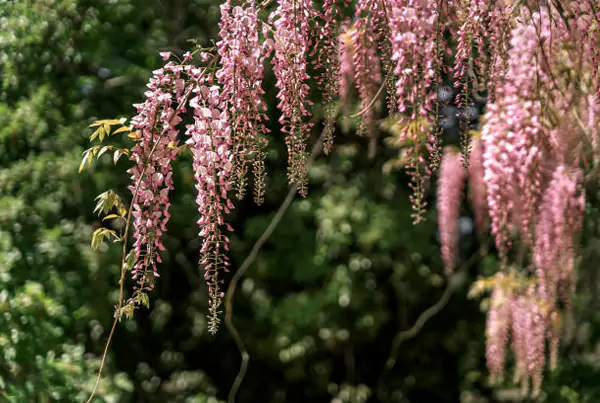
Wisterias are tall, climbing vines that bear dense clusters of little flowers in the spring. This flower, which can grow up to 30 feet long, is frequently used for cascading outdoors. Several pollinators, including bees, birds, and butterflies, are drawn to this fragrant blossom. Give the vine a strong framework to climb, such as a balcony or trellis. To maintain a balanced structure, trim it in late winter or early spring.
| Botanical Name | Wisteria |
| Signifies | New life |
| Sunlight Required | Full to partial sun |
| Preferred Soil | Moist but well-drained |
| Hardiness Zones (USDA) | 2 to 11 |
| Blooming Period | Spring to early summer |
With that, let’s quickly take a look at some of the bright pink and magenta flowers.
Top Hot Pink Flowers Names With Gardening Tips
Ranging from small blooms to large tubular petals, these blossoms have a huge diversity. So, without further ado, let’s continue our exploration with these hot pink flowers!
Calla Lily

Calla lilies, despite their name, are not typical lilies. These perennial plants, native to Africa, are one of the 28 species of the genus Calla. With heights of one to three feet, their distinctive bloom and stamen make them easy to identify.
| Botanical Name | Zantedeschia aethiopica |
| Signifies | Innocence and beauty |
| Sunlight Required | Full sun |
| Preferred Soil | Well-drained, loose sandy soil |
| Hardiness Zones (USDA) | 8 to 10 |
| Blooming Period | Late spring through summer |
Chrysanthemum

Chrysanthemums are a popular choice for people residing in colder regions. These pink bulbs, having tens of layers, can bloom in autumn and occasionally in winter too. Originating from China, they are available in 40+ different varieties. Their flowers are known to help relieve pain, sore throats, and indigestion.
| Botanical Name | Chrysanthemum |
| Signifies | Happiness and love |
| Sunlight Required | Full to partial sun |
| Preferred Soil | Well-drained, sandy |
| Hardiness Zones (USDA) | 5 to 9 |
| Blooming Period | Late summer through fall |
Primrose
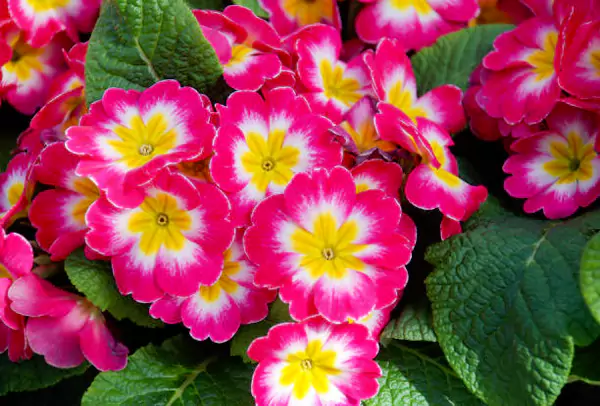
Often referred to as ‘pink ladies’, these delicate blossoms are distinguished by their pastel petals that fade into a lighter inner circle accented with a golden stamen. They require little upkeep and also come in a range of non-pink hues, including blue, yellow, white, and purple.
| Botanical Name | Oenothera |
| Signifies | Young love and attachment |
| Sunlight Required | Partial shade |
| Preferred Soil | Well-drained, loamy, or sandy |
| Hardiness Zones (USDA) | 2 to 8 |
| Blooming Period | Early spring to summer |
Pink Hydrangea
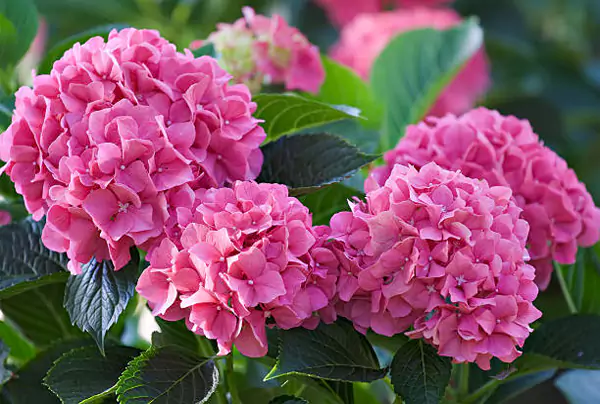
Hydrangeas come in more than 70 varieties, and they are easily identified by the luxuriant clusters of blooms that emerge from green foliage. As the word ‘hydra’ suggests, growing these beloved bridal bouquet flowers calls for a lot of water.
| Botanical Name | Hydrangea macrophylla |
| Signifies | True feelings |
| Sunlight Required | Full sun to partial shade |
| Preferred Soil | Sandy, with peat moss |
| Hardiness Zones (USDA) | 3 to 10 |
| Blooming Period | Mid-spring through summer |
Lotus
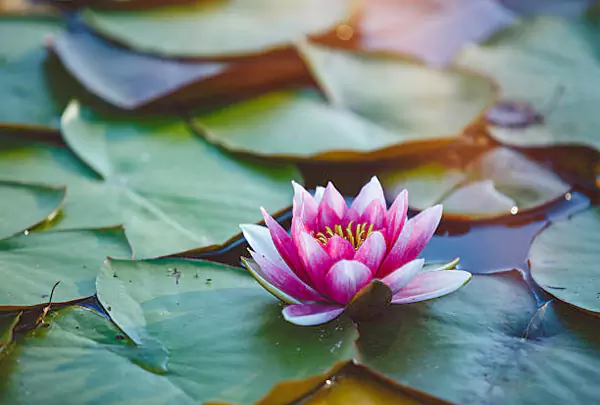
Honored by Buddhists, lotus flowers symbolize enlightenment, as they can blossom exquisitely over dirty or murky water. Although they can be grown in a container with pea gravel and water, they are frequently observed floating in magnificent ponds.
| Botanical Name | Nelumbo nucifera |
| Signifies | Enlightenment and resilience |
| Sunlight Required | Full sun |
| Preferred Soil | Gravel and water |
| Hardiness Zones (USDA) | 4 to 12 |
| Blooming Period | Summer |
Peony
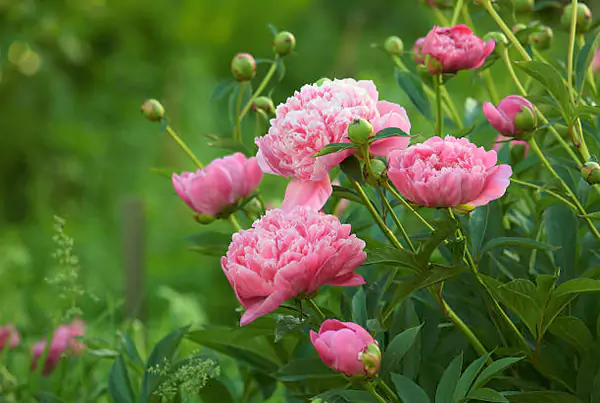
Native to Asia, Southern Europe, and North America, Peonies have fascinated mankind for millennia. They continue to yield enormous, fragrant pink blooms for almost a century after they are planted. Due to this, they’re one of the favored flowers for bridal bouquets and decor.
| Botanical Name | Paeonia |
| Signifies | Good fortune and honor |
| Sunlight Required | Full sun |
| Preferred Soil | Loamy |
| Hardiness Zones (USDA) | 3 to 9 |
| Blooming Period | Late spring to early summe |
Rocktrumpet
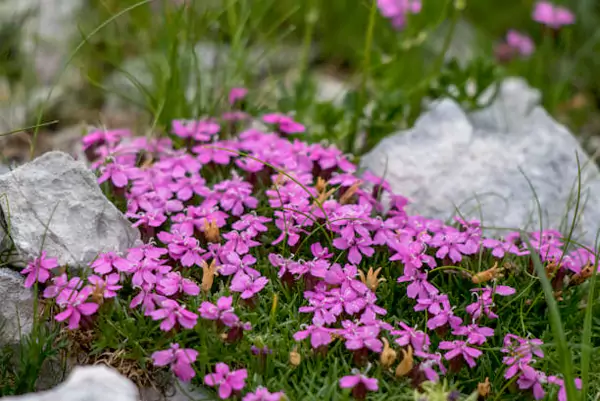
Rocktrumpet flowers are excellent for growing on trellises, fences, and building facades as they provide a nice tropical atmosphere. These buds thrive in warmer regions, but if you live in a cooler place, you can bring them inside for the winter. Those who like a shorter variety can go for Mandevilla Sanderi, which only reaches two to seven feet.
| Botanical Name | Mandevilla |
| Signifies | Whimsy |
| Sunlight Required | Full sun |
| Preferred Soil | Well-drained, loamy, or sandy |
| Hardiness Zones (USDA) | 9 to 11 |
| Blooming Period | Summer to early fall |
Pink Snapdragons

The key to their name lies in the way the blooms mimic the gaping mouth and snout of a dragon. At the top of the stem, they develop a long, dense cluster of blossoms that contrast sharply with the green leaves. Snapdragons, in contrast to most other flowers on this list, like to blossom in the cooler months.
| Botanical Name | Antirrhinum majus |
| Signifies | Grace and protection |
| Sunlight Required | Full sun |
| Preferred Soil | Well-drained |
| Hardiness Zones (USDA) | 7 to 10 |
| Blooming Period | Fall through spring |
Stargazer
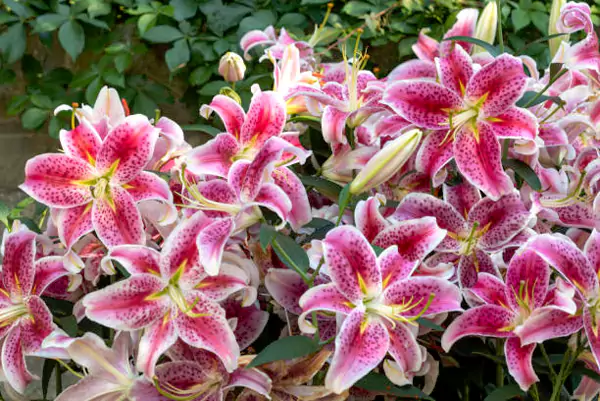
Stargazers, as is obvious, foster a star-shaped pattern of petals. The vibrantly colored flower has tiny spots with a long stamen, making it favorable for bouquets and floral arrangements. However, it has some toxins, so it should be kept away from children and animals.
| Botanical Name | Lilium orientalis ‘Stargazer’ |
| Signifies | Ambition and wealth |
| Sunlight Required | Full to partial sun |
| Preferred Soil | Well-drained, loamy |
| Hardiness Zones (USDA) | 4 to 9 |
| Blooming Period | Summer |
Alyssum
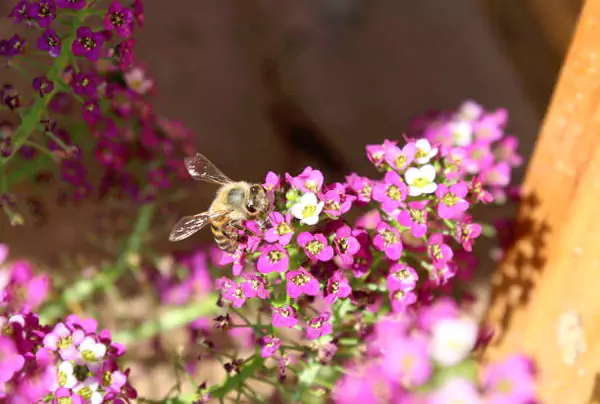
Sweet alyssum, another name for this perennial pink flower, boasts clusters of tiny purple, white, yellow, and, of course, pink blossoms. Because of the flowery cascade that spills over the edges, they are popularly placed in hanging planters and gardens.
| Botanical Name | Lobularia maritima |
| Signifies | Gentility, Calmness |
| Sunlight Required | Full to partial sun |
| Preferred Soil | Well-drained and moist |
| Hardiness Zones (USDA) | 5 to 9 |
| Blooming Period | Late spring to fall |
Candy Mountain Foxglove

These extraordinarily towering perennial flowers are laden with enormous, rosy pink, bell-shaped blooms. Due to their distinctive form and nectar, hummingbirds are drawn to foxgloves. Give the seedlings or seeds adequate room to grow when you plant them. Mulch the area around the base of the plants to retain moisture.
Additional Tip: Given their long flower spikes, staking may be necessary for foxgloves. Plus, to encourage regular flowering and prevent self-seeding, deadhead wilted blossoms whenever possible.
| Botanical Name | Digitalis purpurea ‘Candy Mountain’ |
| Signifies | Secrets |
| Sunlight Required | Full to partial sun |
| Preferred Soil | Moist but well-drained |
| Hardiness Zones (USDA) | 4 to 7 |
| Blooming Period | Early to mid-summer |
Gerbera Daisy

This perennial flower grows in several colors, but pink and yellow are the most favorite ones so far. These spectacular plants can span up to a half foot in height with a bush-like structure. To ensure a continuous bloom, keep the plant fertilized and cut off faded flowers regularly.
| Botanical Name | Gerbera jamesonii |
| Signifies | Innocence, Loyal love |
| Sunlight Required | Full to partial sun |
| Preferred Soil | Well-drained, loamy, or sandy |
| Hardiness Zones (USDA) | 6 to 11 |
| Blooming Period | Early spring to late summer, sometimes fall |
Sweetpea

The delightful aroma of these little pink blossoms is well-known in soaps, lotions, and perfumes. Their subtle scent matches the exquisite pink blossoms crowning the slender stems and tiny leaves. Despite the small size, their prominent fragrance makes them stand out in gardens and bridal bouquets.
| Botanical Name | Lathyrus odoratus |
| Signifies | Gratitude |
| Sunlight Required | Full to partial sun |
| Preferred Soil | Sandy, well-drained |
| Hardiness Zones (USDA) | 2 to 11 |
| Blooming Period | Late spring to summer |
Pink Candytufts
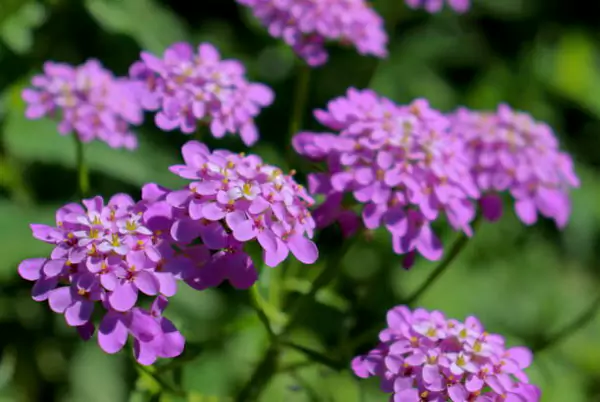
Candytufts, which truly resemble rippling ribbon candies, cover any near-ground open spaces with an explosion of blooms. Despite its candy-like appearance, this flower doesn’t smell like any sugary treat. Pink Candytufts are great as ground covers or edging plants since they require little upkeep. However, due to their unpleasant scent, they should not be kept near open windows.
| Botanical Name | Iberis sempervirens |
| Signifies | Indifference |
| Sunlight Required | Full to partial sun |
| Preferred Soil | Moist but well-drained |
| Hardiness Zones (USDA) | 2 to 11 |
| Blooming Period | Mid-spring to late spring |
Rose Campion

Perched on towering stems, this plant boasts vivid pink blooms and gorgeous green foliage. As a hardy perennial, Campion needs very little maintenance. With its nectar-rich flowers, it will attract bees and butterflies, adding a pop of pink to your garden with a dash of liveliness.
| Botanical Name | Silene coronaria / Lychnis coronaria |
| Signifies | Loyalty, Love, Devotion |
| Sunlight Required | Full to partial sun |
| Preferred Soil | Loamy/Sandy, well-drained |
| Hardiness Zones (USDA) | 2 to 11 |
| Blooming Period | Late spring to summer |
If you provide your plants with ample water, sunlight, and, of course, lots of care, they will surely bloom and make your surroundings more joyful. Take note of the growing needs of the seedling to nurture it into a healthy adult.
For further details on any of the plants, you can take guidance from the Wikipedia guide on flowers present in the US and nearby regions.
Wrapping You a Bouquet!
Pink with flowers is undoubtedly the most heavenly combination out there. Among every flower, pink flowers are known to symbolize sweetness, grace, innocence, and joy.
Take this article as a guide in your journey to growing your favorite flowers in your gardens. With every flower blooming with a distinctive meaning, these pink fellows are surely what you need to cheer you up every day.
List of US state flowers by Wikipedia